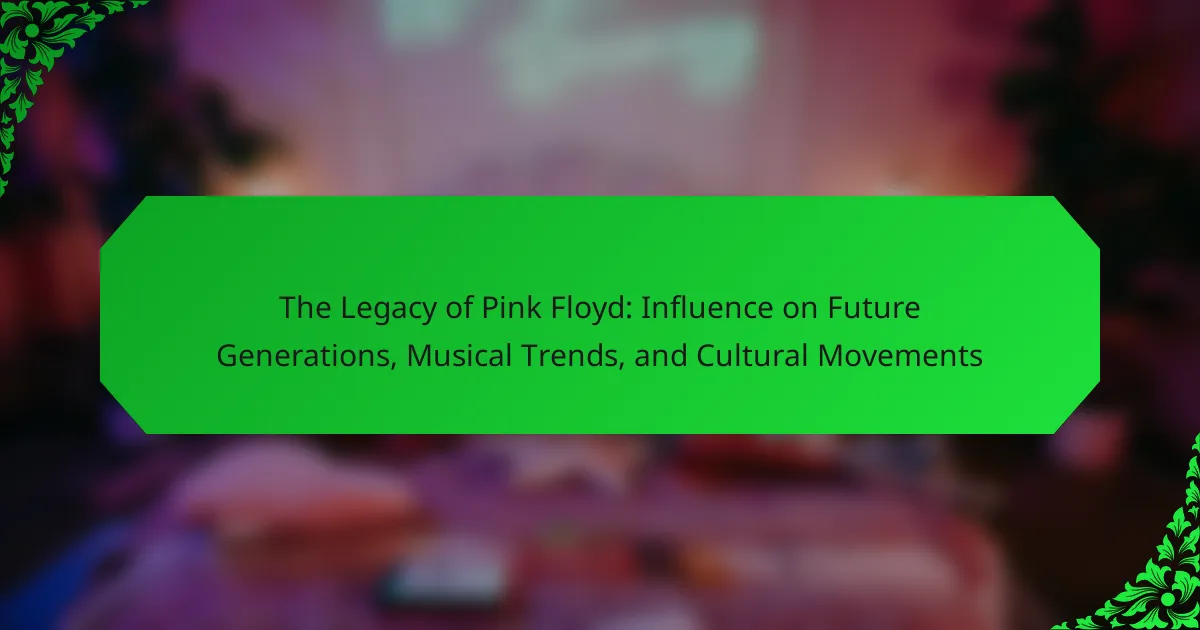Pink Floyd is a seminal rock band known for their profound influence on music and culture, particularly within the progressive rock genre. Their innovative soundscapes and conceptual albums, such as “The Dark Side of the Moon” and “The Wall,” have left an indelible mark on the music industry, exploring complex themes like mental health and societal issues. The band’s elaborate live performances set new standards for concert experiences, while their artistic evolution reflects a response to societal changes. Pink Floyd’s legacy continues to inspire future generations of musicians and shape modern rock, demonstrating their enduring cultural significance.

What is the Legacy of Pink Floyd?
The legacy of Pink Floyd encompasses their profound impact on music and culture. Pink Floyd revolutionized the progressive rock genre with innovative soundscapes and conceptual albums. Their work, particularly “The Dark Side of the Moon,” has sold over 45 million copies worldwide. The band’s use of elaborate live shows set new standards for concert experiences. Pink Floyd’s exploration of themes like mental health and societal issues resonated deeply with audiences. Their artistic vision influenced countless musicians across various genres. The band’s music continues to inspire new generations, shaping the landscape of modern rock. Pink Floyd’s legacy is a testament to their creativity and cultural significance.
How did Pink Floyd shape the music industry?
Pink Floyd shaped the music industry through innovative album concepts and elaborate live performances. They pioneered the use of concept albums, with “The Dark Side of the Moon” achieving unprecedented commercial success. This album remained on the Billboard 200 chart for 741 weeks, influencing the format of albums as cohesive artistic statements. Pink Floyd also introduced advanced sound engineering techniques, such as quadraphonic sound, enhancing the listening experience. Their theatrical live shows incorporated visual art and storytelling, setting new standards for concert experiences. The band’s exploration of philosophical themes in their lyrics resonated with audiences, impacting songwriting trends. Their influence persists, inspiring countless artists across various genres.
What are the key albums that defined their sound?
The key albums that defined Pink Floyd’s sound are “The Dark Side of the Moon,” “Wish You Were Here,” and “The Wall.” “The Dark Side of the Moon,” released in 1973, showcased innovative studio techniques and concept album structure. It became a cultural landmark, remaining on the Billboard charts for over 900 weeks. “Wish You Were Here,” released in 1975, highlighted themes of absence and alienation, reflecting band member Syd Barrett’s struggles. “The Wall,” released in 1979, presented a rock opera format and addressed personal and societal issues. Each of these albums significantly influenced rock music and established Pink Floyd’s legacy.
How did their innovative techniques influence other artists?
Pink Floyd’s innovative techniques significantly influenced other artists by introducing experimental soundscapes and conceptual albums. Their use of synthesizers and studio effects reshaped the sound of rock music. Albums like “The Dark Side of the Moon” set new standards for production quality. This encouraged artists to prioritize thematic coherence in their work. The band’s incorporation of visual elements in live performances inspired a generation of musicians to enhance their shows. Their approach to storytelling through music influenced genres beyond rock, including pop and electronic music. Many contemporary artists cite Pink Floyd as a key inspiration in their creative processes. Their legacy continues to resonate in modern music, showcasing the lasting impact of their innovative techniques.
What cultural movements were influenced by Pink Floyd?
Pink Floyd influenced several cultural movements, notably the counterculture of the 1960s and 1970s. Their music became a soundtrack for anti-establishment sentiments. The band’s exploration of themes like alienation and mental health resonated with the youth. This connection fostered the rise of progressive rock as a genre. Additionally, their elaborate live shows contributed to the development of performance art in music. The psychedelic movement drew inspiration from their innovative sound and visual experiences. Pink Floyd’s impact also extended to the environmental movement, particularly with “Earth” themes in their later works. Their legacy continues to inspire contemporary artists and movements today.
How did their music reflect societal changes in the 1960s and 1970s?
Pink Floyd’s music reflected societal changes in the 1960s and 1970s through its exploration of themes like alienation, war, and mental health. Their album “The Dark Side of the Moon” addressed the pressures of modern life and the human condition. This resonated with a generation facing political unrest and social upheaval. Songs like “Another Brick in the Wall” critiqued the educational system and authoritarianism. The band’s use of innovative soundscapes mirrored the era’s counterculture movements. Their concerts often featured elaborate visual effects, symbolizing the desire for freedom and self-expression. Pink Floyd’s work captured the zeitgeist of a transformative period in history.
What role did Pink Floyd play in the counterculture movement?
Pink Floyd played a significant role in the counterculture movement of the 1960s and 1970s. Their music encapsulated the sentiments of rebellion and social change. The band’s innovative sound and thematic depth resonated with anti-establishment views. Albums like “The Piper at the Gates of Dawn” and “The Dark Side of the Moon” addressed issues such as mental health, war, and consumerism. Their use of psychedelic imagery and elaborate live shows contributed to the visual and cultural landscape of the era. Pink Floyd’s influence extended beyond music, shaping the philosophies of the counterculture. Their work inspired generations to question authority and explore consciousness. The band’s legacy is a testament to their impact on cultural movements.
Why is Pink Floyd’s legacy relevant today?
Pink Floyd’s legacy is relevant today due to its profound influence on music and culture. The band revolutionized the concept of the album as an art form. Their work, particularly “The Dark Side of the Moon,” has sold over 45 million copies worldwide. Pink Floyd’s exploration of complex themes resonates with contemporary societal issues. Their innovative use of sound and visual effects set a standard in live performances. The band’s critiques of war and capitalism remain pertinent in today’s political climate. Their music continues to inspire new artists across various genres. Pink Floyd’s enduring popularity is evidenced by their continued streaming success and cultural references.
How do contemporary artists draw inspiration from their work?
Contemporary artists draw inspiration from their work by exploring themes of identity and experience. They often reflect on personal narratives and societal issues. Many artists analyze their previous creations for new insights. They also seek feedback from peers and audiences to gauge emotional impact. Collaborations with other artists can spark new ideas and directions. Additionally, contemporary artists utilize technology and multimedia to expand their creative horizons. Historical influences, such as iconic bands like Pink Floyd, also shape their artistic vision. This blend of introspection and external influences fosters innovative and meaningful art.
What impact have they had on modern music genres?
Pink Floyd has significantly influenced modern music genres, particularly progressive rock, psychedelic rock, and electronic music. Their innovative use of soundscapes and concept albums set a new standard for artistic expression. The band’s incorporation of philosophical themes and experimental techniques inspired countless artists. For example, their album “The Dark Side of the Moon” has been cited as a major influence on the development of ambient music. Additionally, their pioneering use of synthesizers and studio effects paved the way for electronic genres. The impact of Pink Floyd is evident in the work of modern bands like Radiohead and Muse, who draw on their stylistic elements. Overall, Pink Floyd’s legacy continues to shape the evolution of contemporary music.

How did Pink Floyd’s music evolve over time?
Pink Floyd’s music evolved significantly from their early work to their later albums. Initially, they were known for their psychedelic sound, as heard in “The Piper at the Gates of Dawn” (1967). This album featured experimental instrumentation and surreal lyrics. As they progressed, they shifted towards more structured compositions. “The Dark Side of the Moon” (1973) marked a turning point with its cohesive themes and innovative production techniques. This album became one of the best-selling records of all time.
In the late 1970s, their music took on a more conceptual approach with “The Wall” (1979). This rock opera explored complex themes of isolation and societal issues. The band’s sound also incorporated orchestral elements and elaborate live performances. Their later works, such as “A Momentary Lapse of Reason” (1987), showcased a more polished sound, influenced by 1980s production styles. Throughout their career, Pink Floyd’s music reflected their artistic evolution and response to societal changes.
What were the major phases in their musical evolution?
Pink Floyd’s musical evolution can be divided into several major phases. The first phase, from 1965 to 1967, featured psychedelic rock with their debut album “The Piper at the Gates of Dawn.” This period showcased their experimental sound and innovative use of studio techniques. The second phase, from 1968 to 1975, marked their transition to progressive rock with albums like “The Dark Side of the Moon.” This album became a cultural phenomenon and highlighted their thematic depth and musical complexity. The third phase, from 1976 to 1983, included more personal and political themes, exemplified by “The Wall.” This rock opera solidified their status as cultural icons. Finally, the post-1985 phase saw a shift towards solo projects and occasional reunions, with “The Endless River” released in 2014, reflecting their enduring legacy. Each phase contributed significantly to their influence on future generations and musical trends.
How did their early work differ from their later albums?
Pink Floyd’s early work differed significantly from their later albums in terms of musical style and thematic content. Their early albums, such as “The Piper at the Gates of Dawn,” featured psychedelic rock and experimental sounds. These works were characterized by whimsical lyrics and a focus on surrealism. In contrast, their later albums, like “The Dark Side of the Moon,” embraced progressive rock elements and complex compositions. The later works often dealt with darker themes, including existentialism and mental health. This shift reflected a maturation in their artistic vision and a desire to explore deeper societal issues. The evolution in their sound and themes marked a significant transition in their musical journey.
What experimentation characterized their later projects?
Pink Floyd’s later projects were characterized by extensive experimentation with sound and technology. They incorporated synthesizers, tape loops, and sound effects to create immersive auditory experiences. The album “The Dark Side of the Moon” exemplified this approach, featuring innovative studio techniques and multi-layered compositions. Their use of non-traditional song structures and lengthy instrumental sections further showcased their willingness to push musical boundaries. Additionally, they experimented with visual elements in live performances, integrating elaborate light shows and projections. This blend of audio and visual artistry influenced countless artists and shaped the evolution of progressive rock.
What themes are prevalent in Pink Floyd’s music?
Pink Floyd’s music prominently features themes of alienation, mental illness, and the critique of societal norms. Their lyrics often explore the human experience and emotional struggles. The album “The Wall” delves into isolation and the impact of fame. “Dark Side of the Moon” addresses the pressures of life and existential concerns. These themes resonate with listeners, reflecting universal human emotions. Pink Floyd’s innovative soundscapes enhance these themes, creating a profound auditory experience. Their work has influenced countless artists and genres, solidifying their legacy in music history.
How do their lyrics address existential and philosophical questions?
Pink Floyd’s lyrics frequently explore existential and philosophical questions. Their songs delve into themes of alienation, the nature of reality, and the human experience. For instance, “Time” reflects on the passage of time and the inevitability of death. The lyrics encourage listeners to consider their own mortality and the choices they make. Similarly, “The Wall” addresses isolation and the barriers individuals create. This concept challenges listeners to reflect on their personal struggles and societal pressures. The band often uses metaphor and imagery to provoke thought. Their work has inspired discussions on existence and consciousness. Pink Floyd’s profound lyrical content has influenced countless artists and thinkers.
What recurring motifs can be found in their discography?
Recurring motifs in Pink Floyd’s discography include themes of alienation, existentialism, and the passage of time. Their lyrics often explore the human condition and psychological struggles. The concept of madness is a prominent theme, highlighted in albums like “The Dark Side of the Moon.” Additionally, the use of soundscapes and experimental instrumentation creates an immersive experience. Nature and technology’s relationship is frequently examined, particularly in “Animals” and “Wish You Were Here.” The motif of war and its consequences appears in “The Wall,” reflecting societal issues. These motifs contribute to their enduring relevance and influence on music and culture.
How did Pink Floyd’s performances influence live music?
Pink Floyd’s performances significantly influenced live music through their innovative use of visual effects and elaborate stage designs. They were pioneers in integrating light shows, projections, and theatrical elements into concerts. Their album “The Dark Side of the Moon” was performed with synchronized visuals, enhancing the audience’s experience. The band’s 1973 tour featured a giant inflatable pig and elaborate backdrops, setting new standards for concert production. Pink Floyd’s focus on concept albums also encouraged other artists to create cohesive live experiences. Their performances emphasized the importance of atmosphere and storytelling in music, influencing generations of musicians. The band’s impact is evident in modern arena shows, where visual artistry is as crucial as the music itself.
What innovative stage designs and effects did they introduce?
Pink Floyd introduced innovative stage designs and effects that transformed live performances. They utilized elaborate light shows, including laser displays and projections. Their use of large screens for visual storytelling was groundbreaking. The band incorporated inflatable props, such as the iconic giant pig in “Animals.” They also experimented with surround sound to enhance audience immersion. The architectural design of their stages often included unique shapes and structures. Pink Floyd’s “The Wall” tour featured a massive wall built to separate the band from the audience. These innovations set new standards for concert experiences in the music industry.
How did their concerts create a unique audience experience?
Pink Floyd’s concerts created a unique audience experience through immersive visual and auditory elements. Their use of elaborate light shows and projections enhanced the musical performance. This combination transformed concerts into multi-sensory events. The band’s innovative stage designs included large-scale props and sculptures. These visual elements complemented their music, creating a cohesive experience. Additionally, the thematic content of their songs resonated deeply with audiences. Their performances often featured extended instrumental sections, allowing for a meditative atmosphere. This approach fostered a sense of connection among attendees. The overall experience set a new standard for live music events.

What is the impact of Pink Floyd on future generations?
Pink Floyd significantly impacts future generations through their innovative music and profound themes. Their albums, especially “The Dark Side of the Moon,” explore complex issues like mental health and societal pressures. This has inspired countless artists across various genres. The band’s use of experimental sounds and concepts has shaped progressive rock and alternative music. Their emphasis on visual artistry in live performances has influenced multimedia presentations in music. Pink Floyd’s philosophical lyrics encourage critical thinking and introspection among listeners. Their enduring popularity is evidenced by continued sales and streaming of their music. The band’s influence can be seen in modern artists who cite them as a key inspiration.
How have they influenced new artists and bands?
Pink Floyd has significantly influenced new artists and bands through their innovative sound and thematic depth. Their use of concept albums has inspired many musicians to explore storytelling in their music. The band’s pioneering approach to sound engineering set new standards in production quality. Artists like Radiohead and Muse cite Pink Floyd as a major influence on their work. Their incorporation of visual elements in live performances has reshaped concert experiences for future artists. The themes of existentialism and social commentary in Pink Floyd’s lyrics resonate with contemporary musicians. This legacy continues to inspire new generations to push creative boundaries. Pink Floyd’s impact is evident in the music of various genres, from progressive rock to alternative and beyond.
Which modern musicians cite Pink Floyd as an influence?
Many modern musicians cite Pink Floyd as an influence. Notable examples include Radiohead, whose experimental sound draws from Pink Floyd’s innovations. Muse also acknowledges Pink Floyd’s impact on their theatrical performances and sonic exploration. The band Tame Impala has mentioned Pink Floyd’s influence in their psychedelic soundscapes. Additionally, artists like Trent Reznor of Nine Inch Nails have expressed admiration for Pink Floyd’s atmospheric compositions. These musicians reflect Pink Floyd’s enduring legacy in contemporary music.
What specific elements of their style have been adopted?
Pink Floyd’s style has been adopted through their use of conceptual albums and elaborate soundscapes. Their emphasis on thematic storytelling in music has influenced many artists. The incorporation of progressive rock elements, such as complex time signatures and extended instrumental sections, is also notable. Additionally, their pioneering use of synthesizers and sound effects has been widely emulated. The band’s visual aesthetics, particularly in live performances and album art, have set a standard for artistic presentation in music. Their exploration of existential themes and social commentary resonates with contemporary musicians. Overall, Pink Floyd’s innovative approach has left a lasting mark on the music industry and continues to inspire future generations.
In what ways has Pink Floyd’s music been preserved in popular culture?
Pink Floyd’s music has been preserved in popular culture through various mediums. Their albums, particularly “The Dark Side of the Moon,” remain iconic and are frequently referenced in media. The band’s innovative use of visuals in concerts has influenced live performances across genres. Additionally, their songs are regularly featured in films, television shows, and commercials, reinforcing their cultural relevance. Tribute bands and cover artists keep their music alive by introducing it to new audiences. Furthermore, Pink Floyd’s themes resonate with contemporary social issues, ensuring ongoing discussions about their work. Their music has also been preserved through numerous documentaries and biographies that explore their impact.
How have their songs been featured in films and media?
Pink Floyd’s songs have been prominently featured in various films and media. Their iconic track “Another Brick in the Wall, Part 2” was used in the film “The Wall,” which is a cinematic adaptation of their album. The song has also appeared in movies like “The Departed” and “The Simpsons Movie.” “Time” has been featured in films such as “The Hangover” and “The Great Gatsby.” Additionally, their music has been utilized in documentaries, notably “The Making of The Dark Side of the Moon.” Their songs have been integral to soundtracks, enhancing emotional depth and narrative. Pink Floyd’s influence extends to video games, with tracks appearing in titles like “Guitar Hero.” Their music continues to resonate across various media platforms, solidifying their cultural impact.
What role do tribute bands and cover artists play in their legacy?
Tribute bands and cover artists play a significant role in preserving and promoting the legacy of iconic bands like Pink Floyd. They recreate the original music, allowing new generations to experience it. These performances often attract fans who may not have had the chance to see the original artists live. Tribute bands also maintain the cultural relevance of the music by introducing it to contemporary audiences. For instance, Pink Floyd tribute acts frequently perform at festivals, keeping the band’s music alive in popular culture. Research indicates that tribute bands can enhance the original band’s fan base, as noted in studies on music nostalgia and audience engagement. This phenomenon underscores how tribute acts contribute to the ongoing appreciation of Pink Floyd’s influence on music and culture.
What lessons can emerging artists learn from Pink Floyd’s journey?
Emerging artists can learn the importance of innovation and experimentation from Pink Floyd’s journey. The band consistently pushed musical boundaries, blending genres and incorporating diverse sounds. Their album “The Dark Side of the Moon” showcased this approach, becoming one of the best-selling albums of all time. Pink Floyd also emphasized the significance of a strong visual identity in their performances. Their elaborate stage designs contributed to the overall experience, setting a standard for live shows. Additionally, they demonstrated the power of storytelling through music. Their concept albums conveyed deep themes and narratives, resonating with audiences. Finally, Pink Floyd’s journey highlights the value of collaboration within a band. Each member brought unique talents, resulting in a richer creative output.
How can artists balance innovation with commercial success?
Artists can balance innovation with commercial success by integrating creativity with market trends. They should research audience preferences while maintaining their unique artistic vision. Collaborating with industry professionals can provide insights into successful strategies. For instance, Pink Floyd innovated with concept albums while still achieving commercial success through relatable themes. Utilizing social media can also help artists gauge public interest and adapt their work accordingly. This approach allows for artistic exploration without alienating potential fans. Ultimately, a blend of originality and market awareness can lead to both critical acclaim and financial viability.
What strategies can be employed to maintain artistic integrity?
Maintaining artistic integrity involves prioritizing personal vision and authenticity in creative work. Artists should stay true to their unique style and message. They can set clear boundaries regarding commercial influences. Regular self-reflection helps artists assess their motivations and goals. Collaboration with like-minded individuals fosters a supportive environment. Engaging with audiences authentically builds trust and connection. Analyzing industry trends while staying grounded in personal values is crucial. Historical examples, like Pink Floyd’s refusal to conform to commercial pressures, illustrate the importance of these strategies. Their commitment to artistic vision led to groundbreaking music that resonated with generations.
The main entity of the article is Pink Floyd, a groundbreaking band known for their innovative contributions to music and culture. The article outlines Pink Floyd’s profound legacy, highlighting their impact on musical trends, particularly in progressive rock and conceptual albums, as well as their influence on cultural movements such as the counterculture of the 1960s and 1970s. Key topics include their major albums, innovative techniques in sound and live performances, and the themes prevalent in their music. Additionally, the article discusses how Pink Floyd’s artistic vision continues to inspire contemporary artists and shapes the landscape of modern music, ensuring their relevance in today’s cultural discourse.
